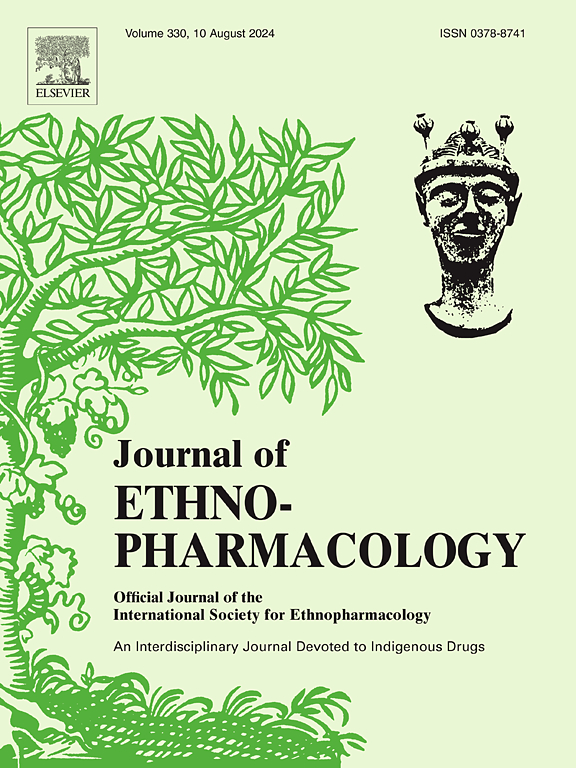Traditional Chinese medicine treatment for epilepsy: Focusing on voltage-gated ion channels
IF 4.8
2区 医学
Q1 CHEMISTRY, MEDICINAL
引用次数: 0
Abstract
Ethnopharmacological relevance
Epilepsy (EP) is a chronic neurological disease, and the clinical treatment of EP is dominated by modern drugs, but one-third of the patients have drug-resistant reactions, which seriously affects the quality of patients' survival. Traditional Chinese medicine (TCM), however, as a promising resource, plays a unique advantage in improving the clinical symptoms of EP and alleviating the adverse effects of modern drug therapy. A large number of studies in recent years have reported that TCM plays an important role in EP treatment by regulating voltage-gated ion channels (VGICs).
Aim of study
This study aims to examine the mechanisms by which VGICs influence EP, providing further elucidate the potential targets of TCM in treating EP by regulating VGICs, including traditional herbal formulas and active compounds. The objective is to offer fresh insights and strategies for the research and management of EP.
Methods
Literature information was obtained from the scientific databases PubMed, Web of Science, EMBASE, Cochrane library, and CNKI, built until June 2024, with search terms including “epilepsy”, “voltage-gated ion channels “, “Chinese medicine” or “herbal medicine”, “medicinal plants”, “natural plants “and “herbal medicine”.
Results
The results suggest that TCM can affect VGICs by influencing the opening of these channels, thereby regulating the currents and concentrations of sodium (Na+), potassium (K+), and calcium (Ca2+). Additionally, TCM modulates the expression of VGIC-related proteins, which in turn affects the release of neurotransmitters, including inflammatory mediators, oxidative stress markers, and glutamate. This process ultimately decreases neuronal excitability and helps inhibit the onset of EP.
Conclusions
By modulating key VGICs such as VGSCs, VGKCs, and VGCCs, TCM plays an important role in the treatment of EP, providing a novel therapeutic strategy based on traditional practices and modern science.

中医治疗癫痫:以电压门控离子通道为重点。
民族药理学相关性:癫痫(EP)是一种慢性神经系统疾病,临床上治疗EP以现代药物为主,但三分之一的患者出现耐药反应,严重影响患者生存质量。而中药作为一种前景广阔的资源,在改善EP临床症状、减轻现代药物治疗不良反应方面具有独特的优势。近年来大量研究报道中药通过调节电压门控离子通道(vgic)在EP治疗中发挥重要作用。研究目的:本研究旨在探讨vgic影响EP的机制,进一步阐明中药通过调节vgic治疗EP的潜在靶点,包括传统中药方剂和活性化合物。其目的是为EP的研究和管理提供新的见解和策略。方法:从PubMed、Web of Science、EMBASE、Cochrane library、CNKI等科学数据库获取文献信息,检索词为“epilepsy”、“voltage-门控离子通道”、“Chinese medicine”或“herbal medicine”、“medicinal plants”、“natural plants”和“herbal medicine”,检索时间截止至2024年6月。结果:结果表明,中药通过影响这些通道的开放,从而调节钠(Na+)、钾(K+)和钙(Ca2+)的电流和浓度,从而影响vgic。此外,中药调节vgic相关蛋白的表达,进而影响神经递质的释放,包括炎症介质、氧化应激标志物和谷氨酸。这一过程最终降低了神经元的兴奋性,并有助于抑制EP的发生。结论:中药通过调节VGSCs、VGKCs、VGCCs等关键vgic,在EP治疗中发挥重要作用,为传统实践与现代科学相结合的EP治疗提供了新的治疗策略。
本文章由计算机程序翻译,如有差异,请以英文原文为准。
求助全文
约1分钟内获得全文
求助全文
来源期刊

Journal of ethnopharmacology
医学-全科医学与补充医学
CiteScore
10.30
自引率
5.60%
发文量
967
审稿时长
77 days
期刊介绍:
The Journal of Ethnopharmacology is dedicated to the exchange of information and understandings about people''s use of plants, fungi, animals, microorganisms and minerals and their biological and pharmacological effects based on the principles established through international conventions. Early people confronted with illness and disease, discovered a wealth of useful therapeutic agents in the plant and animal kingdoms. The empirical knowledge of these medicinal substances and their toxic potential was passed on by oral tradition and sometimes recorded in herbals and other texts on materia medica. Many valuable drugs of today (e.g., atropine, ephedrine, tubocurarine, digoxin, reserpine) came into use through the study of indigenous remedies. Chemists continue to use plant-derived drugs (e.g., morphine, taxol, physostigmine, quinidine, emetine) as prototypes in their attempts to develop more effective and less toxic medicinals.
 求助内容:
求助内容: 应助结果提醒方式:
应助结果提醒方式:


